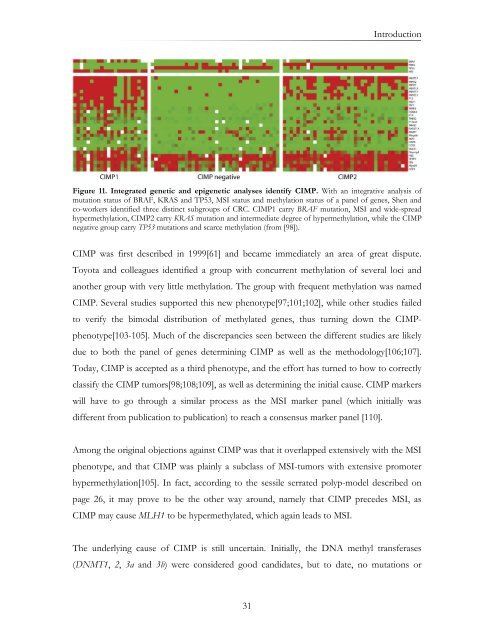Novel genetic and epigenetic alterations in ... - Ous-research.no
Novel genetic and epigenetic alterations in ... - Ous-research.no
Novel genetic and epigenetic alterations in ... - Ous-research.no
You also want an ePaper? Increase the reach of your titles
YUMPU automatically turns print PDFs into web optimized ePapers that Google loves.
IntroductionFigure 11. Integrated <strong>genetic</strong> <strong>and</strong> epi<strong>genetic</strong> analyses identify CIMP. With an <strong>in</strong>tegrative analysis ofmutation status of BRAF, KRAS <strong>and</strong> TP53, MSI status <strong>and</strong> methylation status of a panel of genes, Shen <strong>and</strong>co-workers identified three dist<strong>in</strong>ct subgroups of CRC. CIMP1 carry BRAF mutation, MSI <strong>and</strong> wide-spreadhypermethylation, CIMP2 carry KRAS mutation <strong>and</strong> <strong>in</strong>termediate degree of hypermethylation, while the CIMPnegative group carry TP53 mutations <strong>and</strong> scarce methylation (from [98]).CIMP was first described <strong>in</strong> 1999[61] <strong>and</strong> became immediately an area of great dispute.Toyota <strong>and</strong> colleagues identified a group with concurrent methylation of several loci <strong>and</strong>a<strong>no</strong>ther group with very little methylation. The group with frequent methylation was namedCIMP. Several studies supported this new phe<strong>no</strong>type[97;101;102], while other studies failedto verify the bimodal distribution of methylated genes, thus turn<strong>in</strong>g down the CIMPphe<strong>no</strong>type[103-105].Much of the discrepancies seen between the different studies are likelydue to both the panel of genes determ<strong>in</strong><strong>in</strong>g CIMP as well as the methodology[106;107].Today, CIMP is accepted as a third phe<strong>no</strong>type, <strong>and</strong> the effort has turned to how to correctlyclassify the CIMP tumors[98;108;109], as well as determ<strong>in</strong><strong>in</strong>g the <strong>in</strong>itial cause. CIMP markerswill have to go through a similar process as the MSI marker panel (which <strong>in</strong>itially wasdifferent from publication to publication) to reach a consensus marker panel [110].Among the orig<strong>in</strong>al objections aga<strong>in</strong>st CIMP was that it overlapped extensively with the MSIphe<strong>no</strong>type, <strong>and</strong> that CIMP was pla<strong>in</strong>ly a subclass of MSI-tumors with extensive promoterhypermethylation[105]. In fact, accord<strong>in</strong>g to the sessile serrated polyp-model described onpage 26, it may prove to be the other way around, namely that CIMP precedes MSI, asCIMP may cause MLH1 to be hypermethylated, which aga<strong>in</strong> leads to MSI.The underly<strong>in</strong>g cause of CIMP is still uncerta<strong>in</strong>. Initially, the DNA methyl transferases(DNMT1, 2, 3a <strong>and</strong> 3b) were considered good c<strong>and</strong>idates, but to date, <strong>no</strong> mutations or31
















